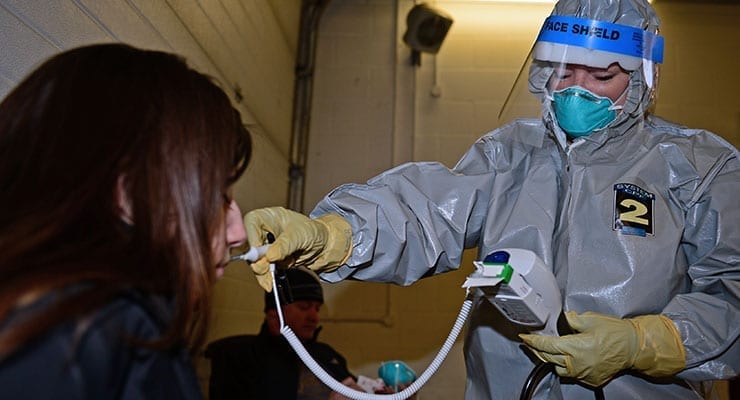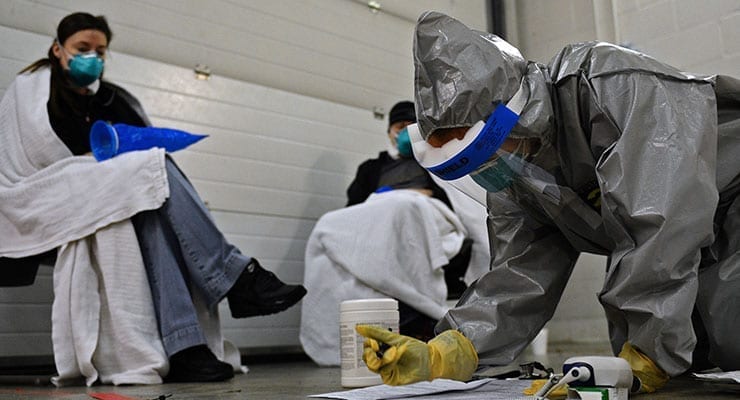On the morning of Feb. 10, two U.S. Air Force personnel reported to the emergency room at RAF Lakenheath, United Kingdom, with symptoms of the pneumonic plague as part of a Disease Containment Plan (DCP) exercise coordinated by the 48th Fighter Wing inspection team.
The patients explained they had recently traveled to Madagascar with other airmen from both RAFs Lakenheath and Mildenhall.
“As most people are aware, there is a huge issue with ebola and measles, but what doesn’t get talked about as much are all the other outbreaks,” said Tech. Sgt. Timothy Carlson, 48th Fighter Wing inspector and exercise planner. “In the military, it’s easy to forget about something small, like a disease, which can cripple our capabilities if we don’t stay prepared.”

The DCP exercise was designed to test the abilities of personnel, from both bases, to respond to and contain a potential contagious disease outbreak.
“As the inspector general, we craft the commander’s inspection program to focus on detecting noncompliance through targeted, detailed and thorough inspection of specific programs, organizations or issues,” said Lt. Col. Kevin Currie, 48th Fighter Wing inspector general. “These exercises are scripted to push the wing past its limits and find the areas we need to improve.”
This iteration was a first, Carlson explained. The DCP had never been executed outside of a conference room before at RAF Lakenheath.
“Typically, when we exercise the DCP, it’s done by conducting a tabletop exercise,” said Master Sgt. Eric Gren, 48th Fighter Wing inspection team section chief. “A full-scale exercise provides a more realistic response and helps to highlight areas of the plan that often get overlooked during a tabletop exercise.”
“This exercise involved every unit on both bases,” Carlson explained. “If this were a real-world event, it would even involve host nation agencies.”
Though the exercise primarily involves the 48th Medical Group and the 48th Mission Support Group, Gren said, it also requires the mobilization of several agencies, including the emergency operations centers, the crisis action teams and the threat working groups of both RAFs Lakenheath and Mildenhall, to name just a few.
The greatest challenge in planning this exercise, Carlson explained, was the amount of coordination and planning between the many different units involved and predicting the many possible outcomes.
“We’re in a unique situation in that the 48th MDG supports two major bases,” Carlson said. “An event like this stresses the ability for two installations to work together seamlessly.”
Carlson echoed Currie’s assessment of the necessity for the large-scale exercises like this.
“Every exercise is a success,” Carlson reiterated. “With the new Air Force inspection system, a deficiency shows us where we need to make improvements. Without the exercise to show us, then we will never know what to fix.”
At the DCP hot wash, where the events of the exercise are discussed and chronicled, the benefits of this exercise, through both its successes and failures, were realized by every group involved.

“If people or their families are sick, then the mission is impacted. If there ever is a need to declare a public health emergency, then the personnel on base need to be assured that the wing knows how to handle the situation so they can focus on their respective jobs,” Gren said.
Col. Robert Novotny, 48th FW commander, has described RAF Lakenheath as a watch, wherein each and every piece is vital for it to function. Gren explained that this has been made evident again through the DCP exercise.
“I think the biggest lesson we can learn is how important each person’s job is to accomplish the mission,” Gren stated. “Take away any one part, and the disease containment plan does not work.”
Article courtesy of Erin Babis, 48th Fighter Wing, edited for context and length.




